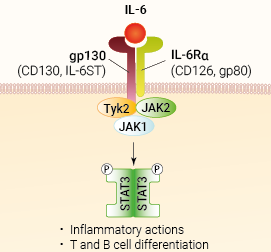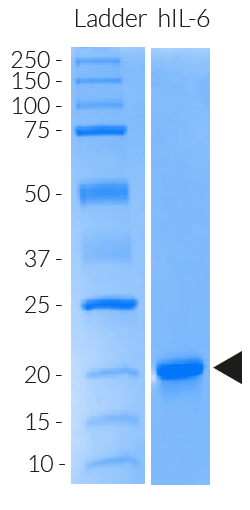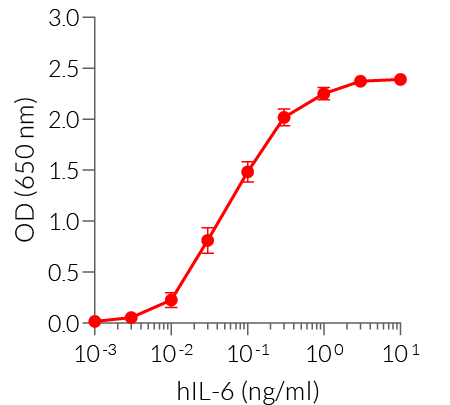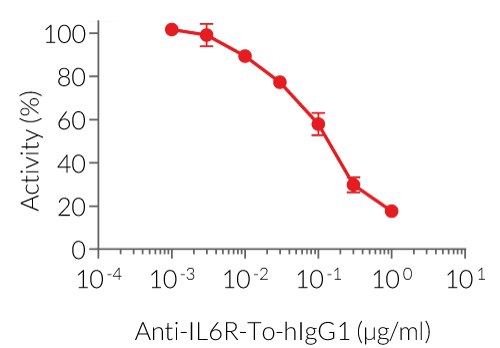Recombinant human IL-6 protein - Bioactive cytokine
| Product | Unit size | Cat. code | Docs. | Qty. | Price | |
|---|---|---|---|---|---|---|
|
Recombinant human IL-6 Recombinant Cytokine, source: E. coli |
Show product |
10 µg 5 x 10µg |
rcyec-hil6
|
|
Human IL-6 protein - E. coli -expressed, tag-free, with HSA
Recombinant human IL-6 is a high-quality and biologically active cytokine, validated using proprietary IL-6 reporter cells. This gp130 cytokine receptor family member is produced in E. coli and thoroughly purified to remove endotoxins.
Recombinant human IL-6 can be used together with HEK-Blue™ IL-6 cells for the screening of inhibitory molecules, such as Tocilizumab, a therapeutic monoclonal antibody targeting the IL-6Rα subunit of the IL-6 receptor (see figures).

IL-6 signaling and biological functions
InvivoGen also offers:
• HEK-Blue™ IL-6 cells
• Anti-IL-6R (Tocilizumab biosimilar)
Key features
- Each lot is validated using HEK-Blue™ IL-6 cells
- Endotoxin ≤ 0.1 EU/µg
- 0.2 µm sterile-filtered
Applications
- Standard for IL-6 detection and quantification assays
- Screening and release assays for antibodies blocking IL-6 signaling
- Screening and release assays for engineered IL-6
Interleukin 6 (IL-6) is a multifunctional cytokine involved in the generation of acute phase proteins, immune responses against pathogens, inflammation, hematopoiesis, cell differentiation, and metabolism. IL-6 overexpression contributes to several inflammatory pathologies, including autoimmune diseases, cancer development, and obesity.
InvivoGen’s products are for research use only, and not for clinical or veterinary use.
Back to the topSpecifications
Source: E. coli
Species: Human
Alternative names: B-cell stimulatory factor 2, CTL differentiation factor, Hybridoma growth factor, Interferon beta-2
Carrier: HSA (human serum albumin)
Tag: Tag-free
Accession number: P05231
Protein size: 183 a.a. (V30-M212)
Molecular weight: ~ 21 kDa (SDS-PAGE)
Solubility: 100 μg/ml in water
Formulation: Phosphate buffer saline (pH 7.4), 5% saccharose, 2% HSA
Sterility: 0.2 µm filtration
Form: Lyophilized
Reconstitution buffer: Endotoxin-free water (provided)
Purity: ≥95% (SDS-PAGE)
Endotoxin: The absence of bacterial contamination (e.g. lipoproteins and endotoxins) has been confirmed using HEK-Blue™ TLR2 and HEK‑Blue™ TLR4 cells.
Tested applications: Cellular assays
Quality control: Each lot is functionally tested and validated
Back to the topContents
Recombinant human IL-6 is provided as a lyophilized powder and is available in two quantities:
- rcyec-hil6: 10 μg
- rcyec-hil6-5: 50 μg (5 x 10 μg)
- 1.5 ml endotoxin-free water for rcyec-hil6 and rcyec-hil6-5
![]() Recombinant human IL-6 is shipped at room temperature.
Recombinant human IL-6 is shipped at room temperature.
![]() Upon receipt, the product should be stored at -20°C.
Upon receipt, the product should be stored at -20°C.
![]() Avoid repeated freeze-thaw cycles.
Avoid repeated freeze-thaw cycles.
Details
The proinflammatory cytokine IL-6 is one of the most important mediators in the regulation of the immune response, hematopoiesis, and inflammation [1]. It plays roles in chronic inflammation, autoimmune diseases, and cancer. In addition, it has been reported to be involved in the cytokine storm triggered by the corona virus disease 2019 (COVID-19) [2].
IL-6 exerts its action by first binding to the IL-6 receptor (IL-6R). The complex of IL-6 and IL-6R associates with the signal-transducing membrane protein gp130, thereby inducing its dimerization (figure 1). This leads to the downstream activation by phosphorylation of certain tyrosine kinases within the Janus family (JAK1, JAK2, and Tyk2). Subsequently, activated JAKs induce phosphorylation, dimerization and translocation of the signal transducer and activator of transcription 3 (STAT3) to the nucleus where it binds enhancer elements of IL-6 inducible genes [3]. Considering the various properties of this pleiotropic cytokine, the IL-6–STAT3 signaling axis is now considered a major target for the treatment of inflammatory diseases [2].
References:
1. Kang S. et al., 2015. Therapeutic uses of anti-interleukin-6 receptor antibody. Int. Immunol. 27: 21-9.
2. Hirano T., 2021. IL-6 in inflammation, autoimmunity and cancer. Int Immunol. 1;33(3):127-148.
3. Murray P., 2007. The JAK-STAT Signaling Pathway: Input and Output Integration. J. Immunol. 178:2623-9.










